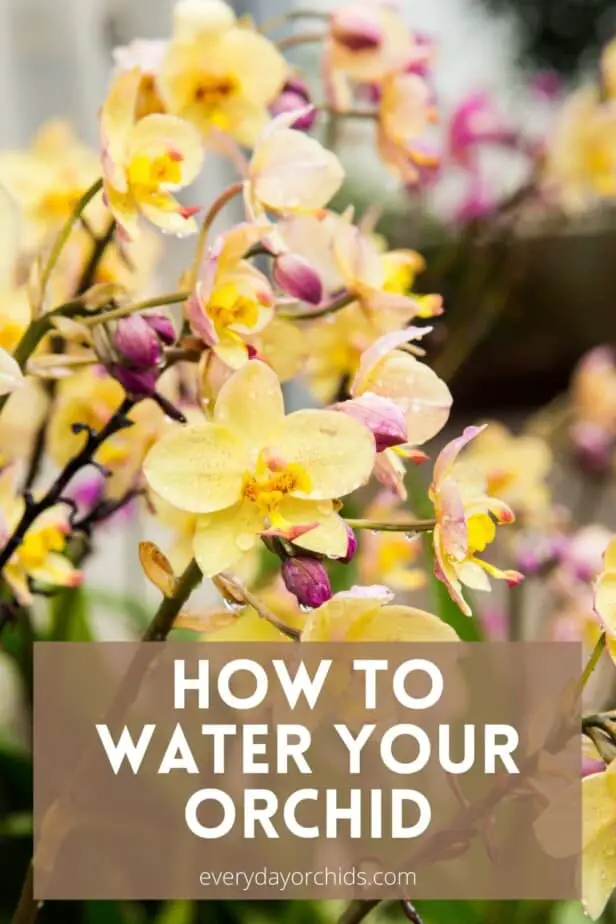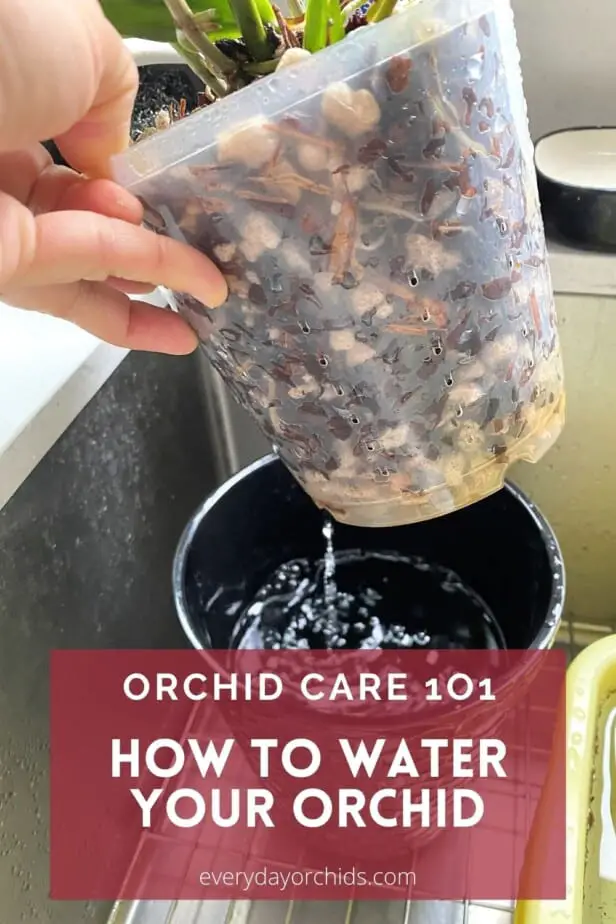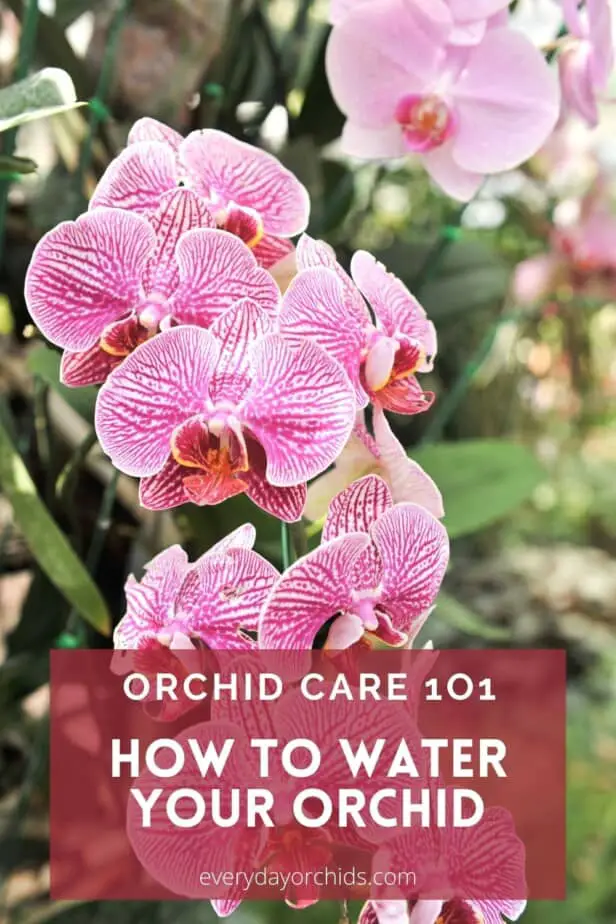Knowing how to correctly water your orchids is fundamental to basic orchid care. However, many beginner orchid growers might accidentally water their orchids similar to how they would water any other houseplant: daily or every other day.
As a result, the orchid starts to die. Novice orchid growers will then water the orchid even more, in a futile attempt to save the orchid’s life. When the plant eventually dies, the person concludes that orchids are just too hard to take care of. But are they?
To water your orchid, use luke-warm water and water the roots and potting media only, making sure you water evenly. Avoid letting water get into the orchid crown or on the leaves, but if it does, just dry it off. Water early in the morning in order to let the excess water drain out by nightfall. Water your orchid when the potting media is nearly dry.
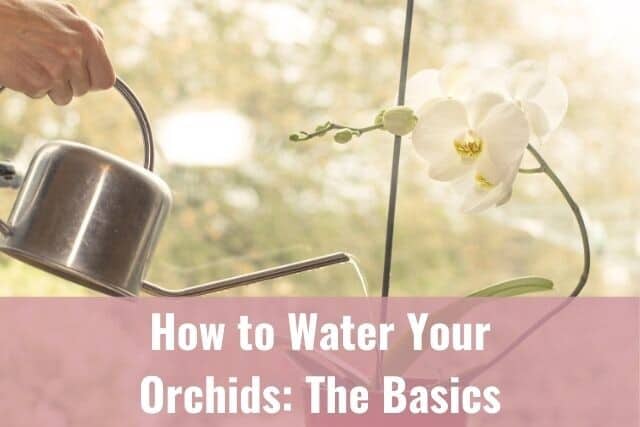
Let’s set the record straight. Orchids are not hard to take care of. With the right knowledge, anyone can successfully grow orchids! I will go over the basics of how to water orchids in this article. You will learn the proper technique for watering orchids, how often to water, and how to tell if your orchid needs more or less water. By the end of this article, you should feel more comfortable with watering your orchid.
Note: In this article, I focus on how to water an orchid grown in traditional orchid potting media made of bark chips. If you have an orchid grown in moss, check out this guide on how to water an orchid grown in moss.
Please note that these links are affiliate links and as an Amazon Associate, I earn from qualifying purchases. Purchases made through affiliate links in this post may generate commissions at no additional cost to you. Use this link for a discounted Amazon Prime trial. Thank you for your support!
Table of Contents
How to Water Orchids

So, why does watering orchids feel so complicated? The major reason for this is, orchids are so different than other houseplants. In fact, they can be down right intimidating to care for. Think about it, the roots look different, the potting media you use is different, and even the way you fertilize your orchid is different than how you fertilize other houseplants. With everything else being different, it makes sense that you would also water your orchids differently than you would your other houseplants.
Watering orchids boils down to two key points: how often to water and how you water, as in, your technique. Yes, there is a specific way to water orchids. Properly watering your orchids can help you avoid root rot, crown rot, and a host of other orchid problems.
Next, I’ll go over how often to water your orchid and when your orchid might need more or less water (and how to tell). Keep reading to learn more.
I will say though, as a caveat, that different orchid species do have specific growth and care requirements. Keep this in mind as you read. Most of these recommendations will work for many commonly cared for orchids. However, if you have a rare, or uncommon orchid variety, it would be best to research that species specifically to find the exact care requirements for your orchid.
If you have an orchid grown in moss, that orchid will need to be watered differently as well. Check out this resource on how to water orchids grown in moss.
How Often To Water Your Orchid
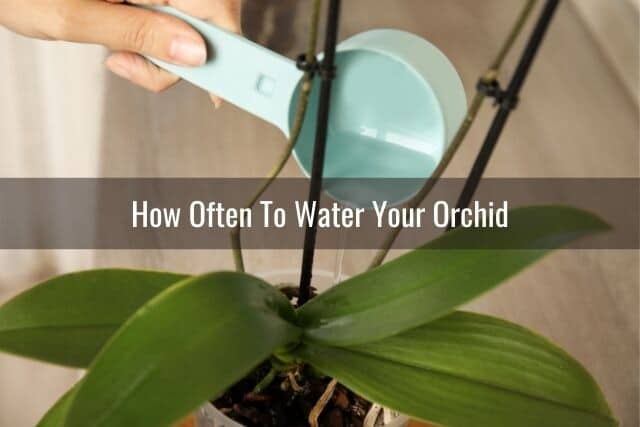
In general, most orchid species will do fine with weekly watering. Water once a week during warmer summer months, and just once or twice a month during colder winter months. Water when the potting media is nearly dry.
As always, you will want to check the potting media before you water. You can either put your finger or a chopstick or a pencil into the potting media to test it. If the potting media is dry, or nearly dry, go ahead and water your orchid. If you aren’t sure, then wait one more day and check it again.
Sometimes, uneven or irregular watering can cause orchid leaves to split, or twist and curl. If you see these happen in your orchid leaves, it may be a sign that you need to adjust your watering frequency.
When Your Orchid May Need More Frequent Watering
Your orchid may need more frequent watering during its growth periods in the spring and summer. If you have a terrestrial orchid, the growth period is also generally the time for pseudobulb growth in these orchids.
Pseudobulbs function as storage organs in plants. They allow the orchid to store extra water and nutrition for periods of drought. As pseudobulbs are developing, naturally, the orchid will need more water to build up those storage organs.
Also, if the weather is very hot where you live, your orchid may need more frequent watering. This might be once every 4 or 5 days, rather than just once a week. Keeping your orchids hydrated will help you avoid your orchid roots becoming dry and shriveled, or your orchid becoming dehydrated. Pay attention to how quickly the potting media dries up during hot weather and water as needed.
For dehydrated orchids, you can use the soaking method to water your orchids, which I talk about below. You can also use an Epsom salt soak for very dehydrated orchids.
Signs that your orchid may need more water include: orchid flowers falling off early, leaves turning limp, wrinkled, or wilting, and roots becoming dried and shriveled. Other signs of underwatering include the orchid failing to produce a new flower spike and a general lack of root and leaf growth.
When Your Orchid May Need Less Frequent Watering
Your orchid will likely need less water during dormancy. Dormancy generally occurs in the winter for most plants. During this time, your orchid is resting. It will not need as much hydration. In addition, cooler weather generally means the potting media will take longer to dry out between waterings.
When in doubt, it is safer to water less often during this time. Just don’t let the potting media dry out completely and stay dry. Otherwise, you risk the orchid roots becoming dried and shriveled and dying. Instead, water when the potting media is nearly dry.
Signs that your orchid may need less water (as in, it is being overwatered) are root rot, fungus gnats in and around the potting media, and wilting and limp leaves.
In addition, mold growth on the potting media or on the outside of a clay pot can indicate excessive moisture. It means the potting media is not drying out fast enough to keep up with watering. Fungal infections, yellowing leaves, and flower loss can also indicate that the orchid is getting too much water.
When to Water Your Orchid: Time of Day

One very important thing to remember about watering orchids is that you want to water them as early in the day as possible. This is so that the orchid pots and potting media can drain away excess water by nightfall, and any water on the leaves or in the crown can evaporate. This will go a long way in terms of preventing crown rot, leaf rot, root rot and other problems.
I generally make it a point to water my orchids early in the morning before or right after breakfast. That gives the orchids all day to drain excess water and somewhat dry out before nighttime. If I get busy and don’t remember to water my orchids until the afternoon, then I just water the next morning instead.
How to Water: The Technique

When you water your orchid, do your best to water the roots and potting media only. To do this, you can use a long-necked watering can such as this one (at the time of this writing, it even comes with a bonus spray bottle, which you can use for misting your orchids).
Alternatively, you can use the soaking method to water your orchids. I’ll talk more about both of these techniques below.
By using a long-necked watering can or the soaking method, you will be able to avoid getting water on the leaves or the crown. This, in turn, will help you avoid rot and infection in your orchid. Contaminated water splashing onto the leaves can lead to brown rot and infection. Water left standing in the orchid’s crown can lead to crown rot.
I don’t want to scare you though. If water gets on the leaves or in the crown of your orchid, it’s not the end of the world. Your orchid will not die. Simply use a paper towel and wipe up the water and soak up the water in the crown. As long as you take care of it right away, your orchid will be fine.
Watering Orchids with a Long-Necked Watering Can
If you are using a long-necked watering can to water your orchid, try to water just the roots and potting media. Water evenly and thoroughly. After watering, be sure you empty the water from the saucers or trays under your orchid pots. Doing so will also help prevent infection and bacterial and fungal growth from occurring.
Watering Orchids Using the Soaking Method
If you want to use the soaking method to water your orchids, you will need a small bucket or basin. I use a basin similar to this one. You can also buy one at your local dollar store.
Place your orchid pots inside. Fill the bucket or basin with luke-warm or room-temperature water up to the rim of the orchid pots. You want the potting media and roots to be able to soak and absorb the water without the potting media floating out of the pot.
Let the orchid sit in the water for at least 5 or 10 minutes, though leaving it longer will not hurt. I have let my orchids soak as long as 20 minutes with no ill effects. Then, remove the orchid pot from the water and let it drain away all the excess water.
A lot of people like to water their orchids in their kitchen sink or bathroom sink. This way, the excess water can just drain into the sink, and you don’t have to worry about emptying water from saucers or trays. In the picture below, my orchid pots were soaking in a basin of water in the kitchen sink.

All of my orchids are potted in plastic orchid pots, then double potted into either ceramic decorative pots or these self-watering pots by Bloem Living. I just have to say, I really like these self-watering pots and find them perfect for double potting my orchids. They come in different colors and there is an elevated drain screen, or reservoir, on the bottom that allows water to drain away from my orchid pots.
After watering my orchids in the morning, I drain out as much excess water as possible from the pots. Then I put my orchid pots back in their pretty self-watering pots (AKA outer container or double pot). The excess water continues to drain down into the reservoir. I appreciate how the inner orchid pot is not sitting in standing water due to the screen divider. Then, before bedtime, I typically empty out the reservoir in the outer pot so there’s no standing water overnight. Easy!
Watering Orchids in a Double Pot
Conversely, if you are double potting your orchid and the outer pot does not have any holes, you can just keep your orchid in its double pot and let it soak there. The outer pot will serve as a “bucket” for the orchid during watering sessions. This is a super easy and simple method for watering orchids!
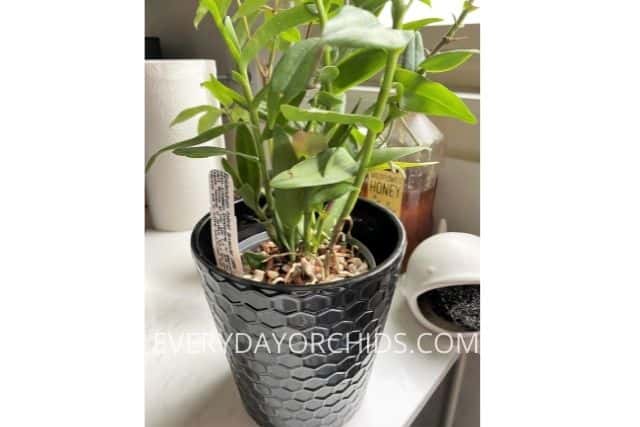

With a long-necked watering can or your kitchen faucet, run water into the plastic orchid pot while it is still double potted. Evenly water the orchid roots and potting media. The water will accumulate into the outer pot. Turn off the water once it reaches the rim of the plastic inner orchid pot. You want all the roots to soak but you don’t want orchid potting media loose and floating everywhere.
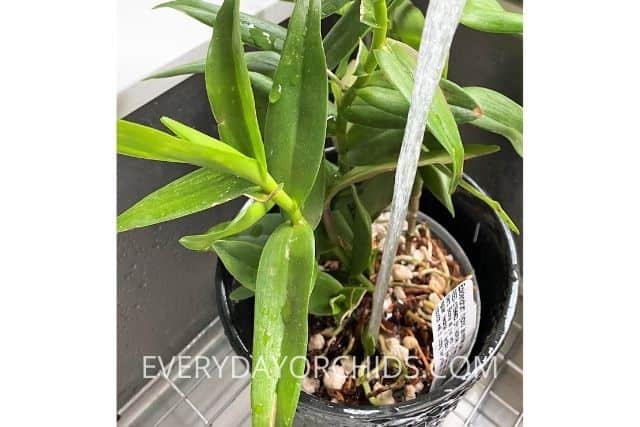
Soak the potting media and roots thoroughly and evenly. Let the orchid sit in the water for at least 5 or 10 minutes.
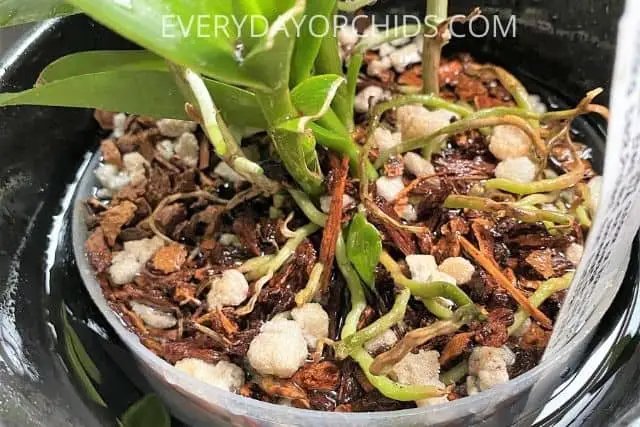
Then, remove the inner orchid pot (the one with the orchid of course). Let it drain thoroughly.
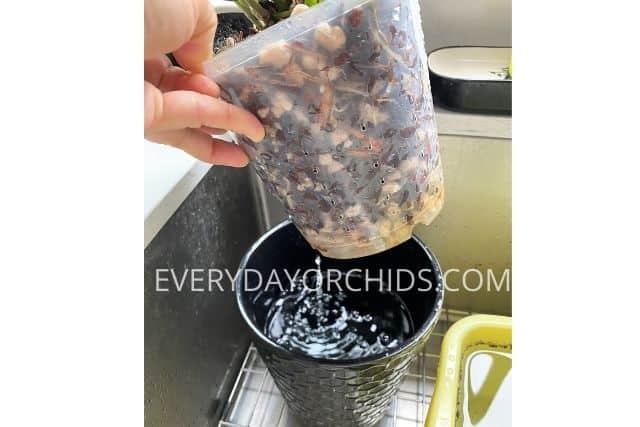
Dump out the water from the outer pot. Once the inner plastic orchid pot has drained off the excess water, you can return it to the outer decorative pot.
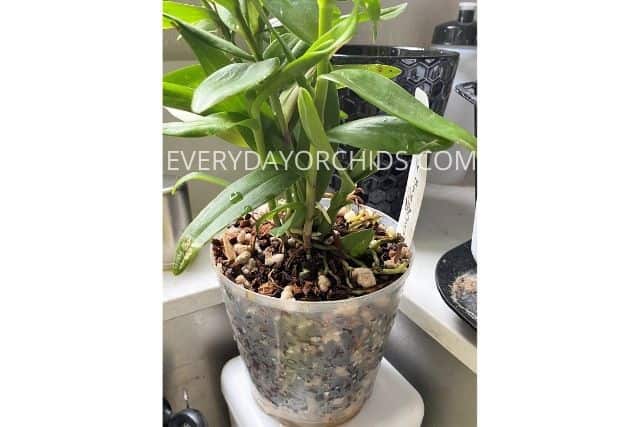
There you go! A quick visual guide on how to water double potted orchids. Honestly, I like this method the best for its simplicity and convenience.
Water Temperature Is Important for Orchids
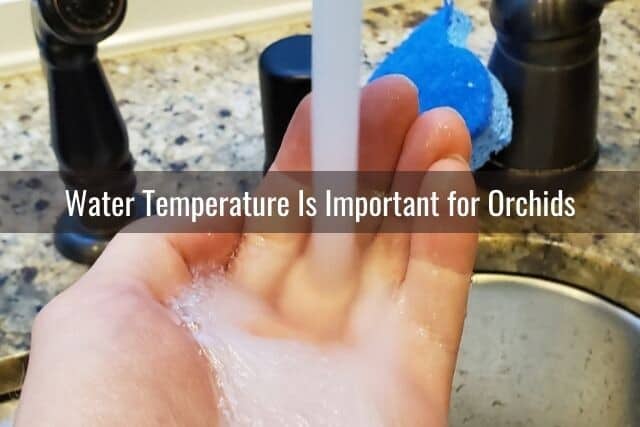
Using the correct water temperature is important when watering your orchids. Hot water will damage the orchid roots, while cold water will shock and stress the orchid. When you water your orchid, use luke-warm or room temperature water.
Remember, when you are caring for your orchid, you are trying to provide growing conditions as close to its native conditions as possible. Many orchids are tropical plants and are exposed to warm tropical water. They are generally not exposed to cold or hot water.
You might have heard of the ice cube method for watering orchids. I would discourage you from using ice cubes to water your orchids. While it may, for a short period of time, not seem to affect the orchid, using cold or freezing water will shock the orchid.
Continued exposure to cold water temperatures repeatedly puts the orchid outside its temperature tolerance levels and adds stress. Inevitably, repeated stress will weaken the orchid and cause growth to slow. A weak orchid will be more susceptible to disease, illness and infestations.
You can read more about the pros and cons of watering your orchid with ice cubes in another article I’ve written.
Watering Epiphyte Orchids vs Terrestrial Orchids
I have just given you a basic overview of how to water your orchid. These principles will work for the majority of orchids, both epiphyte and terrestrial orchids. However, it is still important for you to know what kind of orchid you have.
As mentioned above, terrestrial orchids may require more watering during growth periods when they are developing pseudobulbs. I talked in more detail about this above.
In general, terrestrial orchids prefer higher humidity and moisture than epiphyte orchids.
How to Water Orchids After Repotting
Now, let’s look at some different scenarios. You may be wondering about whether you should water your orchid after repotting or how to balance fertilizing your orchids with watering your orchids. Let’s get into that.
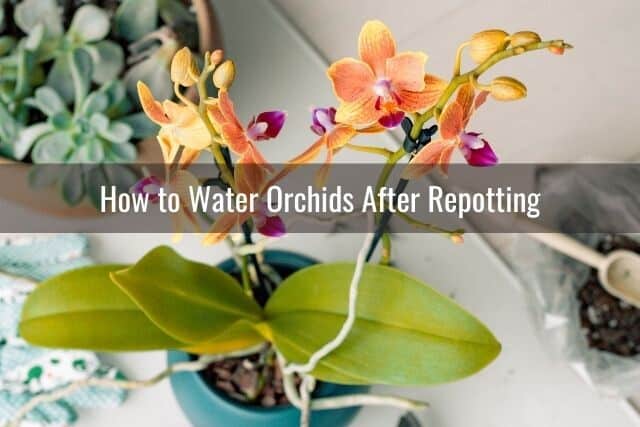
After you repot your orchid, you may notice that your orchid leaves may start to wilt and become limp. This may happen for several reasons. Repotting is a stressful event for orchids, and during that process, you likely trimmed off a number of dead or dried roots.
More importantly though, you have just changed the potting media from one that was likely decomposing to a new orchid potting media. The older potting media was likely broken down and retaining more water, exposing the roots to moisture for longer periods of time.
The newer potting media, however, has large bark pieces that allow for rapid drainage and drying. This, in turn, has the potential to lead to reduced water absorption by your orchid and subsequent dehydration. You will see this manifested in the wrinkled, wilted orchid leaves.
If you see this starting to happen, you’ll need to take some steps to rehydrate your orchid. I’ll go into that next.
Preventing Wilting or Dehydration After Repotting
To prevent wilting and dehydration in your orchid after repotting, you can take a few preventive measures before and during repotting.
Before repotting your orchid, you can pre-soak your new potting media in a bucket of water. This will hydrate it and add some moisture and humidity to your orchid’s environment after it is repotted.
I talk more about how to prepare your potting media in my article about how to repot your orchid. Please check that out if you’d like to learn more.
During the repotting process, you can immerse the orchid roots in a bucket of clean water and gently wash off any old potting media that may be stuck to the roots. This process will probably take at least several minutes. Not only is this a nice, gentle way of getting the old potting media off, but it also gives your orchid’s roots an opportunity to rehydrate and absorb the water.
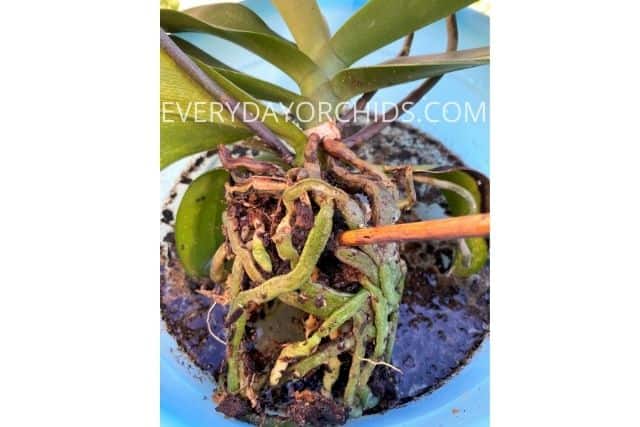
After your orchid is repotted, you will want to keep a closer eye on the orchid in the following days. Since you had pre-soaked the potting media in water during repotting, your orchid will likely not need to be watered immediately following repotting.
However, beginning a few days after you have repotted your orchid, check the potting media and see if your orchid needs to be watered. Use your finger or a chopstick to touch the top two inches of potting media. Gauge how dry or damp it is. If it is dry, go ahead and water your orchid. If it is still fairly damp, wait a day or two and check again.
After repotting your orchid in new media, you may need to increase the frequency of your watering sessions to accommodate for the better draining potting media and drier environment.
When you do water your orchid, I would recommend soaking your orchid pots (outlined in the “how to water” section above) to really give your orchid roots a chance to absorb the water and rehydrate.
How to Water Orchids During Blooming Season

When your orchid is entering its blooming season, you want to make sure that the potting media does not completely dry out. Water your orchid when the potting media is nearly dry.
Infrequent watering or irregular watering practices will cause the potting media to dry out. This will result in disrupting the orchid’s blooming season.
In fact, underwatering is one of the top reasons why orchid flowers and buds fall off early. It is very disappointing when those long-awaited orchid blooms fall off the spike, so don’t let this happen to you.
After the blooming season is done, the orchid enters a growth period. During this time, the orchid is focused on root growth. It is gathering the energy and nutrients it needs to produce another flower spike and bloom again.
When an orchid is in its growth period, it will need more light, fertilizer and, of course, water. Make sure you are watering your orchid generously and regularly during this time.
Watering and Fertilizing Orchids
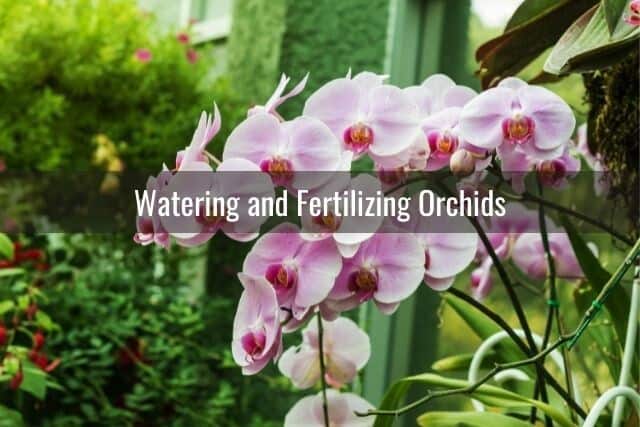
You may be wondering how fertilizing orchids factors into the watering schedule. I have written extensively about how to fertilize your orchids. Knowing how to fertilize an orchid, as well as how to prepare orchid fertilizer is important, so be sure to check out that article.
As for whether or not you should water your orchid before fertilizing, well, there is some debate about that. Some people feel you should water after fertilizing, while others feel you should water, then fertilize. I lean more towards the latter.
Watering your orchids first will allow the roots and potting media to get wet, reducing the risk of root burn from the fertilizer. It will also “prime” the roots and make sure they are able to absorb the key nutrients from the fertilizer. For these reasons, I feel it is more beneficial to the orchid to water briefly first, then follow up with a diluted orchid-specific fertilizer.
Remember, many orchid specific fertilizers are sold in the concentrated form. You will need to prepare the fertilizer by diluting it with water per the product instructions.
Moreover, many orchids prefer weak fertilization. You can further dilute the prepared orchid fertilizer by adding more water to bring it to a quarter-strength or half-strength concentration.
Since the orchid fertilizer is mixed with a large amount of water, you will not need to water your orchid too much before fertilizing. It will get water when it is fertilized. You can provide enough water before fertilizing to moisten the roots and potting media. This way, they are not totally dry when the fertilizer is applied.
Choosing an Orchid Fertilizer
There are a variety of orchid-specific fertilizers available on the market. When buying one, you can choose one to your specific orchid’s needs.
For example, if you are trying to encourage your orchid to produce bigger, more abundant blooms, you can buy a bloom booster fertilizer. SunBulb sells a highly rated bloom booster fertilizer for orchids. Likewise, Jack’s Classic Bloom Booster fertilizer helps orchid buds set and encourages prolific blooming seasons.
No matter what you choose, if you are looking to help your orchid bloom or rebloom, choose an orchid fertilizer with higher phosphorus levels.
If you are looking for a balanced orchid fertilizer that will nourish your plant and help it grow, try this highly-rated orchid fertilizer by rePotme. Many orchid fertilizers out on the market will likely work for your orchid. If you need help on how to choose an orchid fertilizer, you can read more on my site. Alternatively, you could also make your own orchid fertilizer using common kitchen scraps.
Final Thoughts
Watering orchids doesn’t have to be difficult or complicated. Just remember the key points: water your orchid when the potting media is nearly dry, use luke-warm water, and water in the mornings. Your orchid may need more frequent watering during hot weather, growth season, or as it prepares for blooming season. Your orchid will need less water during dormancy (winters).
If you can, pot your orchid in a plastic orchid pot. These pots are lightweight and see-through, allowing you to see when your orchid roots or potting media might be getting dry. You can also easily pick these up and with some practice, be able to tell just by the weight, if the orchid needs more water or not.
Hope this helps and happy orchid growing!
If you enjoyed this article, please pin it and share!
